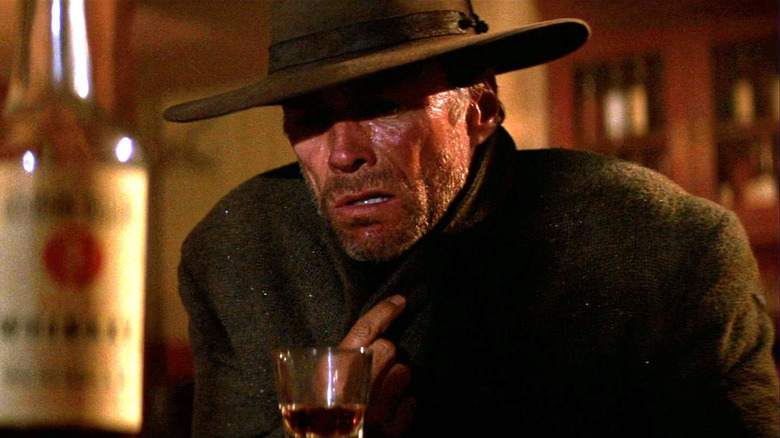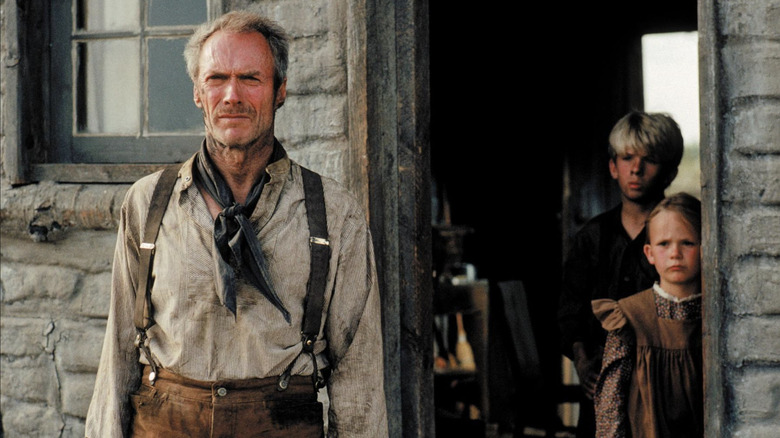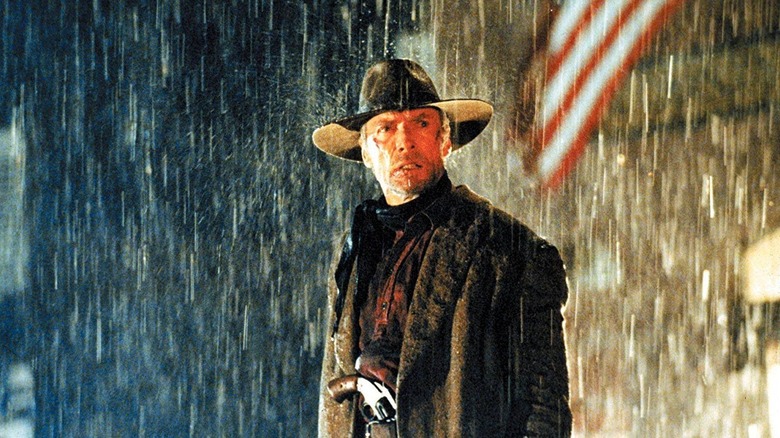Unforgiven's Original Ending Was A Scene Inspired By The Godfather
No one could have made "Unforgiven" like Clint Eastwood did. Revisionist westerns weren't novel anymore by 1992. What makes the movie special is how it humanizes the face of the genre. Eastwood, who had played ruthless, stoic Western archetypes in his younger days, was now portraying a man who struggled to mount his horse, aim his gun, or keep his vow not to kill. Eastwood's presence transforms the character William Munny from a deconstruction into a career postscript. "Unforgiven" is the epilogue to every gunslinging cowboy Eastwood ever played, from Blondie to Josey Wales.
And yet, the movie didn't originate with Eastwood. It was first written by David Peoples in 1976 and titled "The Willliam Munny Killings." Eastwood got his hands on it during the 1980s but waited about a decade to actually make it. For the 30th anniversary of "Unforgiven" in 2022, Peoples spoke with Yahoo Entertainment, shedding some light on both how he wrote it and the movie's original ending.
The original ending
When we meet Munny, he's widowed farmer with a young son and daughter. The reason he's lured out of retirement is because he hasn't taken to agriculture like he did to murder. Bounty hunting gives him a needed chance to provide for his kids. After Munny departs his homestead, we don't see his children again, though the epilogue notes they and their father supposedly moved to San Francisco at some point.
That's because the film chooses to end right after the final shootout. Munny dispatches Little Bill Daggett (Gene Hackman), Sheriff of Big Whiskey, then rides out of town through a dark and stormy night, having once more become an angel of death. According to Peoples, there was originally one more scene after this: Munny arrives back home and lies to his children that he didn't kill anyone. Peoples explained:
"What's good about that scene is that it means that the killings aren't triumphant killings. Munny doesn't say, 'I killed that motherf***er.' He's ashamed of what he's done."
Peoples noted the ending was inspired by "The Godfather." If you don't know, the classic film ends with Michael Corleone (Al Pacino) lying to his wife Kay (Diane Keaton), telling her he didn't have his traitorous brother-in-law Carlo (Gianni Russo) murdered. As Michael enters his office, Kay turns around. When she looks back at him, mobsters are paying reverence to "Don Corleone," before one of them shuts the door on Kay. Michael's fall to evil is complete and Kay's husband is lost to her.
"Unforgiven" and "The Godfather" are both about men failing to do good, choosing evil because it's the easiest way in the world they inhabit.
The proper place to stop
Despite the fitting homage, Eastwood decided to cut the scene. According to Peoples, the director felt "that it was a beat too many:"
"He had this sense that the movie had already ended, and sticking on another scene wasn't going to help. As the sensitive writer, I wish somehow it could have made it in, but he got the rhythm right. He has a brilliant sense of drama."
Unlike the viewing public, Peoples got to see the abandoned ending in a preview screening arranged by Eastwood himself. The scene has never been made available elsewhere, whether online or as a bonus feature in any "Unforgiven" home media release. It seems unlikely that it will ever be released, especially since "Unforgiven" is not in need of an expanded "director's cut."
This "Godfather"-inspired ending sounds like a good scene on its own terms and I would be curious to watch it. However, Eastwood was absolutely right that it would disturb the film's rhythm. Everything the scene would have communicated is already there when Munny leaves Big Whiskey. Editing a movie isn't just about whether a scene works on its own terms, its about how it serves the larger tapestry. This one didn't, so it was rightfully excised.


